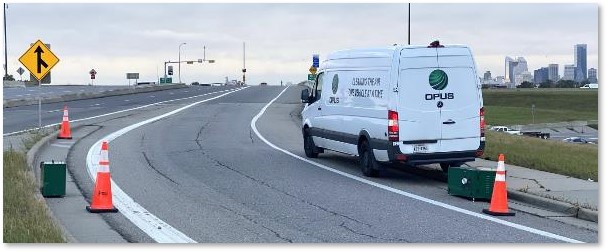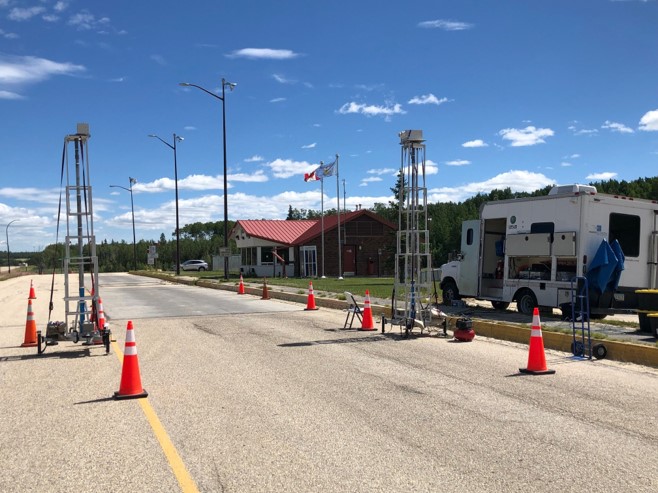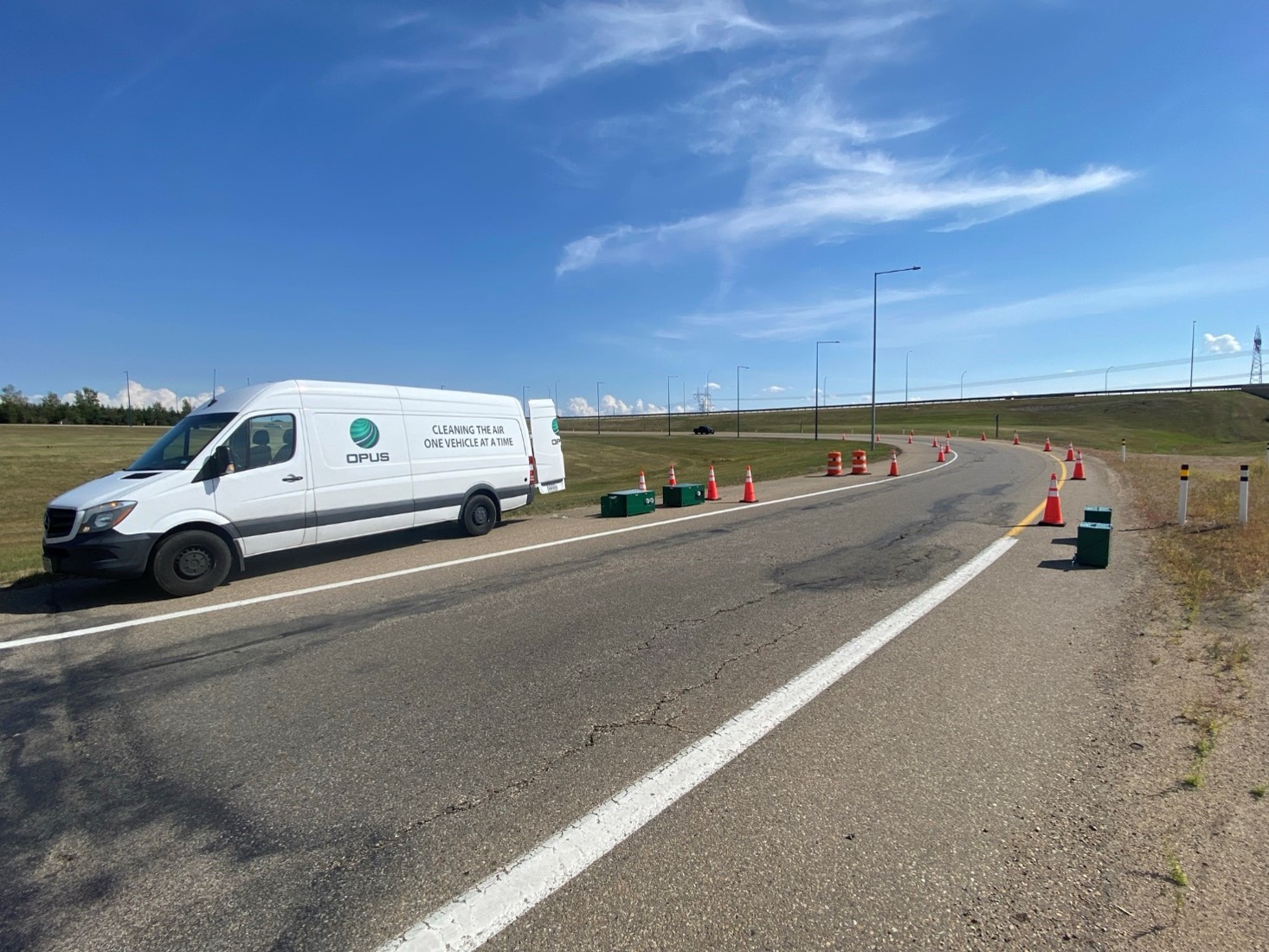Project Scope
The Roadside Optical Vehicle Emissions Reporter (ROVER) III Project Team used remote sensing technology to test emissions from the in-use on-road vehicle fleet, including heavy-duty and light-duty vehicles, and will make recommendations on managing emissions from the on-road transportation sector in Alberta.
The focus of this work is diesel-fuelled trucks but data was also collected on other heavy-duty vehicles (e.g., buses) and light-duty vehicles (e.g., personal vehicles). The emissions of focus include oxides of nitrogen (NOx), volatile organic compounds (VOCs), carbon monoxide (CO), carbon dioxide (CO2), and particulate matter (PM) . Recommendations to reduce these substances are expected to have the co-benefit of reducing other emissions, such as greenhouse gases.
Project Goal and Objectives
To measure emissions from the in-use on-road transportation sector, particularly diesel-fueled trucks, to inform management actions and/or next steps for transportation emissions management to help achieve the CAAQS in Alberta.
The project goal is broken down into the following objectives:
- Compile and review information and agree on a common understanding of current transportation emissions and their management in Alberta.
- Undertake an on-road vehicle emissions testing study (or studies) to gather data on emissions from in-use on-road light-duty and heavy-duty vehicles, focusing on diesel-fuelled trucks.
- Develop a vehicle emissions profile for the in-use on-road vehicle fleet based on data from Objective 2 and compare results from this and similar studies.
- Evaluate and recommend management actions and/or next steps to reduce emissions from the in-use on-road vehicle fleet based on the outcomes of Objectives 1 and 3.
- Develop and implement a strategy and action plan for communicating the work of the project team, and on vehicle emissions and their impact on air quality.
Project Status
Project work began in April 2018, with most of the light-duty vehicle testing being completed in 2020 and 2021. The remaining data collection, including the heavy-duty vehicle emissions, was conducted over the summer of 2022. The project team will develop a final report that includes key findings based on the data collection and other sources of information and a suite of recommendations. The project team’s report is expected to be publicly available in mid-2024.
Documents
- Amended ROVER III Project Charter (April 2024)
- A Survey of On-Road Light and Heavy-Duty Vehicle Emissions, OPUS Report (2023)
- CASA ROVER III Final Report
- CASA ROVER III Backgrounder
- CASA ROVER III Factsheet
Articles
- Article by CTV News Edmonton, August 2021 -Vehicle exhaust in Edmonton and four Alberta cities monitored as part of study on air pollution
- Article by the Lethbridge Herald, July 2022 -Emissions project monitoring pollution on Alberta roads
Videos
Background
The CASA Project on Non-Point Sources (2015 – 2017) aimed to help to address non-point source air emissions contributing to ambient fine particulate matter (PM2.5) and ozone standard non-achievement in Alberta and had a large focus on the transportation sector. The ROVER III project was informed by recommendations from that project.
Based on the 2014 Air Pollutant Emissions Inventory, the on-road transportation sector is a large emission source of NOx (particularly heavy-duty diesel vehicles, followed by light-duty gasoline trucks and other vehicles), a source of VOCs (particularly light-duty gasoline trucks and other vehicles), and a source of primary PM2.5 (particularly heavy-duty diesel vehicles). In 2012, the International Agency for Research on Cancer classified diesel engine exhaust as carcinogenic to humans based on evidence that exposure is associated with an increased risk for lung cancer. More recently, Health Canada published a document that categorizes the relationship between lung cancer and diesel exhaust as causal based on a weight-of-evidence analysis of epidemiological data as well as identifying a suggestive relationship between bladder cancer and diesel exhaust.
Previous ROVER Projects
The earlier ROVER I and ROVER II projects were completed in Alberta through CASA. In 1998, the ROVER I project assessed actual in-use vehicle emissions in Edmonton, Calgary, Red Deer, and Canmore using a remote sensing van equipped to measure carbon monoxide in exhaust plumes. Exhaust from over 42,000 light-duty vehicles was measured. It also communicated with Albertans about vehicle emissions. The final report can be found here.
In 2006 the project was repeated as ROVER II, testing over 66,000 vehicles in the same four municipalities. This time the team measured exhaust emissions of nitric oxide, particulate matter, hydrocarbons, carbon monoxide, and carbon dioxide. ROVER II found emissions per kilometer were falling but vehicle use was increasing. Furthermore, the results indicated that although the number of higher emitters was relatively small at 5%, they contributed a larger proportion of emissions (60% of carbon monoxide, 31% of hydrocarbons, 26% of nitric oxide, and 7% of particulate matter). The final report from this work can be located here.
For more information on the ROVER series of projects, please contact Project Manager Katie Duffett at kduffett@awc-casa.ca
Field Tour Photos
The following photos depict various stages and sites throughout the 2022 - 2023 data collection period. Many thanks and credit to OPUS Inspection Inc. for allowing CASA to share these important photos.















